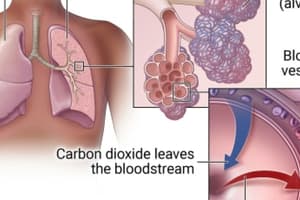Podcast
Questions and Answers
Which stage of the disease is characterized by hemodynamic instability, generalized edema, and hypoxemia?
Which stage of the disease is characterized by hemodynamic instability, generalized edema, and hypoxemia?
- Stage 4
- Stage 3 (correct)
- Stage 2
- Stage 1
Which stage of the disease is characterized by mediator-induced disruption of the vascular bed and increasing interstitial and alveolar edema?
Which stage of the disease is characterized by mediator-induced disruption of the vascular bed and increasing interstitial and alveolar edema?
- Stage 2 (correct)
- Stage 1
- Stage 3
- Stage 4
Which stage of the disease is characterized by progressive lung fibrosis, ventilation management difficulties, increased airway pressures, and multiorgan involvement?
Which stage of the disease is characterized by progressive lung fibrosis, ventilation management difficulties, increased airway pressures, and multiorgan involvement?
- Stage 1
- Stage 2
- Stage 3
- Stage 4 (correct)
Which of the following is true about uncompensated pH levels?
Which of the following is true about uncompensated pH levels?
In compensated pH levels, what is true about the Paco2 and the HCO3?
In compensated pH levels, what is true about the Paco2 and the HCO3?
What is checked to determine which side of 7.40 the pH level occurs?
What is checked to determine which side of 7.40 the pH level occurs?
Which of the following can cause ventilation/perfusion mismatches in the lungs?
Which of the following can cause ventilation/perfusion mismatches in the lungs?
Which condition can cause low ventilation/perfusion in the lungs?
Which condition can cause low ventilation/perfusion in the lungs?
Which of the following is not a pulmonary cause of impaired lung tissue integrity?
Which of the following is not a pulmonary cause of impaired lung tissue integrity?
Flashcards are hidden until you start studying
Study Notes
Stages of Disease
- Hemodynamic instability, generalized edema, and hypoxemia characterize the early stage of the disease.
- Mediator-induced disruption of the vascular bed and increasing interstitial and alveolar edema are evident in the intermediate stage.
- Progressive lung fibrosis, difficulties in ventilation management, increased airway pressures, and multiorgan involvement occur in the late stage of the disease.
pH Levels
- Uncompensated pH levels indicate an acid-base disturbance that the body cannot correct.
- Compensated pH levels show that the body has adjusted either Paco2 or HCO3 to stabilize the pH but original disturbance is still present.
pH Level Measurement
- The pH level is assessed to determine whether it is above or below 7.40, establishing acidemia or alkalemia.
Ventilation/Perfusion Mismatches
- Causes of ventilation/perfusion mismatches include various lung diseases, pulmonary embolism, and conditions affecting air movement or blood flow in the lungs.
- Conditions causing low ventilation/perfusion ratios can include severe asthma, pneumonia, and chronic obstructive pulmonary disease (COPD).
Pulmonary Causes of Impaired Lung Integrity
- Non-pulmonary causes of impaired lung tissue integrity may include conditions like heart failure or systemic infections, rather than direct lung damage.
Studying That Suits You
Use AI to generate personalized quizzes and flashcards to suit your learning preferences.




